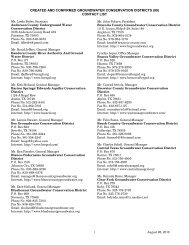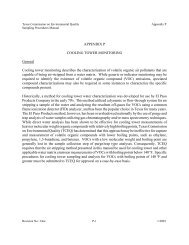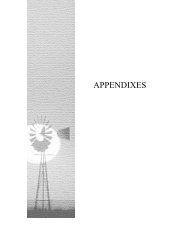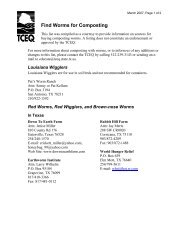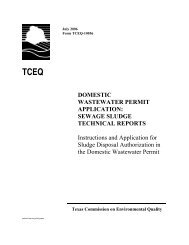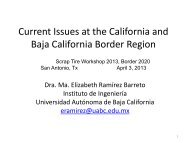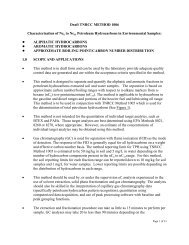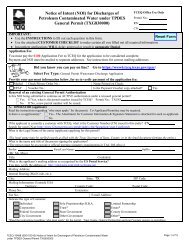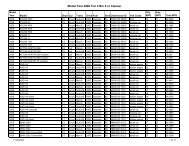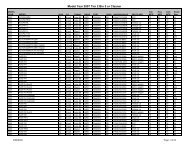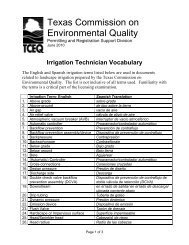joint groundwater report - Texas Commission on Environmental ...
joint groundwater report - Texas Commission on Environmental ...
joint groundwater report - Texas Commission on Environmental ...
You also want an ePaper? Increase the reach of your titles
YUMPU automatically turns print PDFs into web optimized ePapers that Google loves.
core program compliance, thus providing the base from which to develop the fully integrating CSGWPP. TheEPA provided comments <strong>on</strong> the core assessment in February 1995. The TGPC has initiated efforts to addressthe EPA’s comments and finalize the <str<strong>on</strong>g>Texas</str<strong>on</strong>g>-specific core program assessment. The TGPC will develop thesix strategic activities of the CSGWPP, including milest<strong>on</strong>es for achieving a fully integrated <str<strong>on</strong>g>groundwater</str<strong>on</strong>g>protecti<strong>on</strong> program.MeetingsThe TGPC meets quarterly; meeting times and agenda are published in the <str<strong>on</strong>g>Texas</str<strong>on</strong>g> Register and <strong>on</strong> theTGPC’s World Wide Web site at . The public is invited to attend all TGPCmeetings and to participate <strong>on</strong> subcommittees. The TNRCC maintains audio tapes and written records of allTGPC meetings. The TNRCC maintains a mailing list of TGPC members, designated and alternate members,agency staff, and interested parties for meeting notificati<strong>on</strong>.Groundwater Protecti<strong>on</strong> PolicySecti<strong>on</strong> 26.401 of the <str<strong>on</strong>g>Texas</str<strong>on</strong>g> Water Code establishes the state’s <str<strong>on</strong>g>groundwater</str<strong>on</strong>g> protecti<strong>on</strong> policy. The policysets out n<strong>on</strong>degradati<strong>on</strong> of the state's <str<strong>on</strong>g>groundwater</str<strong>on</strong>g> resources as the goal for all state programs. The policyrecognizes the variability of the state's aquifers, the importance of maintaining water quality for existing andpotential uses, the protecti<strong>on</strong> of the envir<strong>on</strong>ment and the public health and welfare, and the maintenance andenhancement of the l<strong>on</strong>g-term ec<strong>on</strong>omic health of the state. Further, the policy recognizes that <str<strong>on</strong>g>groundwater</str<strong>on</strong>g>c<strong>on</strong>taminati<strong>on</strong> may result from many sources, including current and past oil and gas producti<strong>on</strong> and relatedpractices, agricultural activities, industrial and manufacturing processes, commercial and business endeavors,domestic activities, and natural sources that may be influenced by, or may result from, human activities. Theuse of the best professi<strong>on</strong>al judgement by the resp<strong>on</strong>sible state agencies in attaining the goal and policy isalso recognized.The policy states that discharges of pollutants, disposal of wastes, and other regulated activities be c<strong>on</strong>ductedin a manner that will maintain present uses and not impair potential uses of <str<strong>on</strong>g>groundwater</str<strong>on</strong>g> or pose a publichealth hazard. The programs of the various state agencies are generally administered to attain this goal. Thestate’s <str<strong>on</strong>g>groundwater</str<strong>on</strong>g> protecti<strong>on</strong> policy is included in Appendix 2.Groundwater Classificati<strong>on</strong> SystemThe <str<strong>on</strong>g>Texas</str<strong>on</strong>g> Groundwater Protecti<strong>on</strong> Committee and its member agencies recognize that <str<strong>on</strong>g>groundwater</str<strong>on</strong>g>classificati<strong>on</strong> is an important tool to be used in the implementati<strong>on</strong> of the state's <str<strong>on</strong>g>groundwater</str<strong>on</strong>g> protecti<strong>on</strong>policy. Through classificati<strong>on</strong>, the <str<strong>on</strong>g>groundwater</str<strong>on</strong>g>s in the state can be categorized and protecti<strong>on</strong> or restorati<strong>on</strong>measures can then be specified by member agencies according to the quality and present or potential use ofthe <str<strong>on</strong>g>groundwater</str<strong>on</strong>g>.The TGPC has developed a <str<strong>on</strong>g>groundwater</str<strong>on</strong>g> classificati<strong>on</strong> system for use by state agencies. Four <str<strong>on</strong>g>groundwater</str<strong>on</strong>g>classes are defined based <strong>on</strong> quality as determined by total dissolved solids (TDS) c<strong>on</strong>tent. The names andc<strong>on</strong>centrati<strong>on</strong> ranges are based <strong>on</strong> traditi<strong>on</strong>al nomenclature associated with each class. Fresh <str<strong>on</strong>g>groundwater</str<strong>on</strong>g> isclassified as having a TDS c<strong>on</strong>centrati<strong>on</strong> range from zero to 1,000 milligrams per liter (mg/L); slightly saline13



